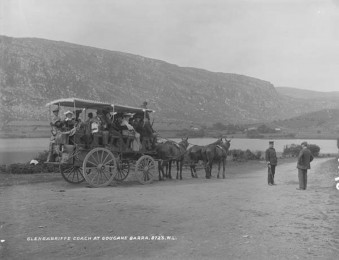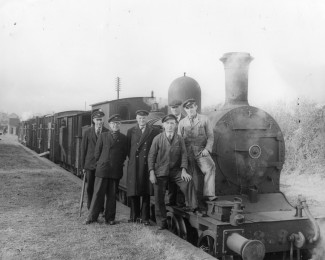
Kieran’s Our City, Our Town Article,
Cork Independent, 20 October 2011
In the Footsteps of St. Finbarre (Part 271)
Routeways in Culture
Continuing on from last week’s column, Fr. Patrick Hurley’s obituary following his death on 25 June 1908 in the Cork Examiner acknowledges him as a staunch advocate of the Irish language movement. He held the Presidency of the first Munster Irish Training College in Ballingeary since its inception in 1903. The college opened for two sessions, July and August in 1904. Mr. Dermot Foley was in charge, assisted by Rev. O’Daly and Mr. Tadgh Scannell.
Lessons were given in the method of teaching Irish phonetics and metrics of Irish poetry. Special classes in text books for national teachers were given as well as conversational lessons, and lectures in Irish history. The language of the school was as much as possible in Irish. Over seventy students attended each session as well as several priests from all parts of Ireland, professors in colleges, national teachers and Gaelic League organisers. The Archbishop of Cashel as well as the Bishop of Cork and the other Bishops of Munster, became patrons of the college. They helped it through donations. Fr. Hurley’s long term plan was that perhaps the college would eventually be housed on the ancient site near Gougane Barra. This did not materialise but the project did start off in the dining area of Cronin’s Hotel.
According to a Southern Star, Ballingeary Notes column on 1 November 1930 Tadhg Scannell hailed from Coolea and until his arrival in Ballingeary, not one pupil it is noted in any national school in the village, or in the parish had been presented for examination in Irish at the Annual Results Examination in the National Schools. Through Tadgh’s interventions he won the national O’Brien Cup for having secured the highest number of passes in all Ireland, three years in succession. He also helped the Christian Brothers to prepare their compiled school text books of the Irish language and he often placed his knowledge of the subject at the disposal of advanced literary students.
Fr. Hurley also promoted an industrial revival amongst local people. His obituary in the Cork Examiner of 1908 further notes that he highlighted scientific agricultural methods, which he passed on to the farmers of the district. He also brought lecturers into the area to share their ideas of cultivation in difficult landscapes for growing crops and dairy farming.
In addition Fr. Hurley pushed for a lace-making industry in the district. He opened up the Gaeltacht countryside by inducing the Tourist Development Company to run coaches to Glengariff and Killarney, via Macroom and Gougane Barra. He successfully lobbied local MPs for the improvement of the roads to bring in more tourism into the region. From that he approached Cork railway companies to create grand tour programmes in West Cork, which created tours to Bantry, Glengarriff with Gougane Barra bring part of a wider itinerary.
An article in the Southern Star on 15 June 1907 (p.5) echoes Fr Hurley’s work and outlines: “The establishment of a motor service along the tourist route from Macroom to Killarney, via Inchigeela, Gougane Barra, Keimaneigh, Glengarriff etc constitutes a decided step towards the development of tourist traffic in the south…the coaches have been doing very on this route for the past number of years, but the motor car possessed advantages that are altogether lacking on the old system. The scenery loses some of its attractiveness, when viewed from the motor-car, and the speed at which the uninteresting parts of the route are covered will offer an opportunity for a pause where the passengers show a desire to contemplate the scenic beauties that present themselves at intervals. In cold and inclement weather too, the motor car will have far greater attraction for the tourist than the open coach that occupies the whole day on the road. In fine weather also new and unbeaten tracks may be opened up by the motor.”
At this time also, the Cork and Macroom Direct Railway Company (1861-1953) also advertised its tourist route to Glengarriff and Killarney via a number of sites (several of which have been written about in Our City, Our Town over the Lee series). An advertisement in the Freeman’s Journal in July 1914 notes that: “Tourists by this route have an opportunity of going through the most scenery in Ireland. Proceeding from Cork to Macroom by Train, the following interesting Ruins, etc., can be seen from the railway carriage, Ballincollig or Barrett’s Castle, Kilcrea Abbey, Crookstown Castle or Castlemore, Mashanaglass Castle, the meeting of the waters at Coolcower Bridge, Lee and Sullane, the meeting of the waters at Macroom Bridge- the Sullane and Laney. On arrival at Macroom by Train, tourists proceed by well-appointed Motor Coaches to Killarney via Glengarriff. The road runs for Four Miles along the fringe of the Celebrated Lakes of Inchigeela, and thence to the far-famed Holy Lake of Lone Gougane Barra, at the source of the Lee, on an island of which is situated the hermitage of St. Finbarre, with the ruins of the Chapel and Cloister. Thence through the magnificent Pass of Keimaneigh (the Khyber of Ireland), admitted to be the finest in the Kingdom. Shortly after leaving the Pass the first grand view is obtained of Bantry Bay.”
To be continued…
Captions:
613a. Coach at Gougane Barra, c.1910 (William Lawrence Photographic Collection)
613b. Photo call on the closing days of Cork and Macroom Direct Railway, 1953 (picture: ESB Archives, Dublin)
